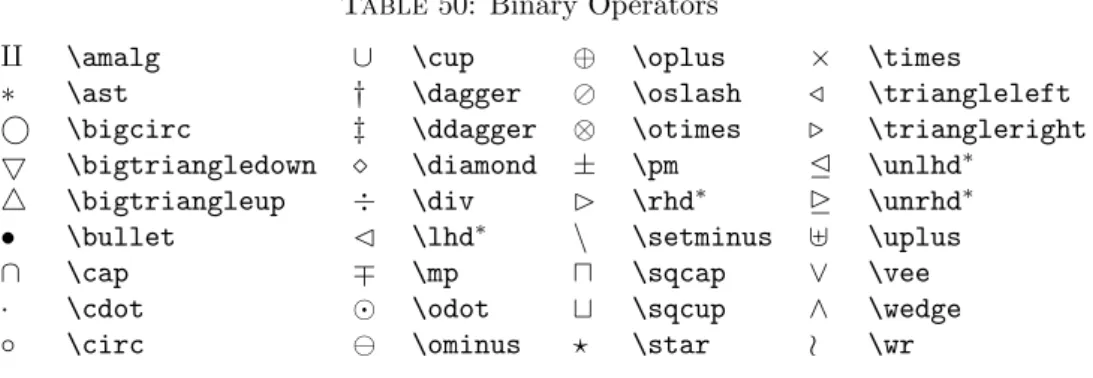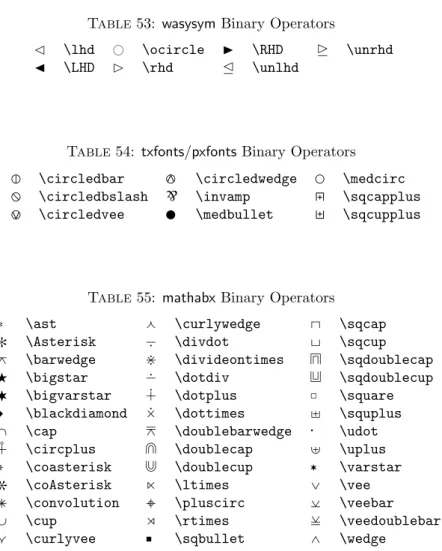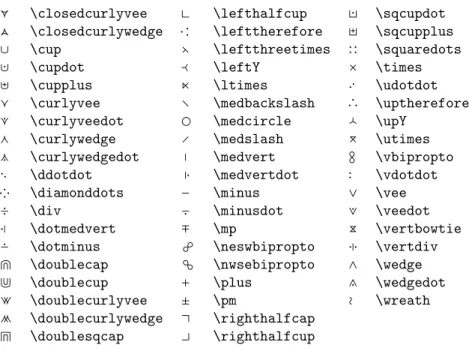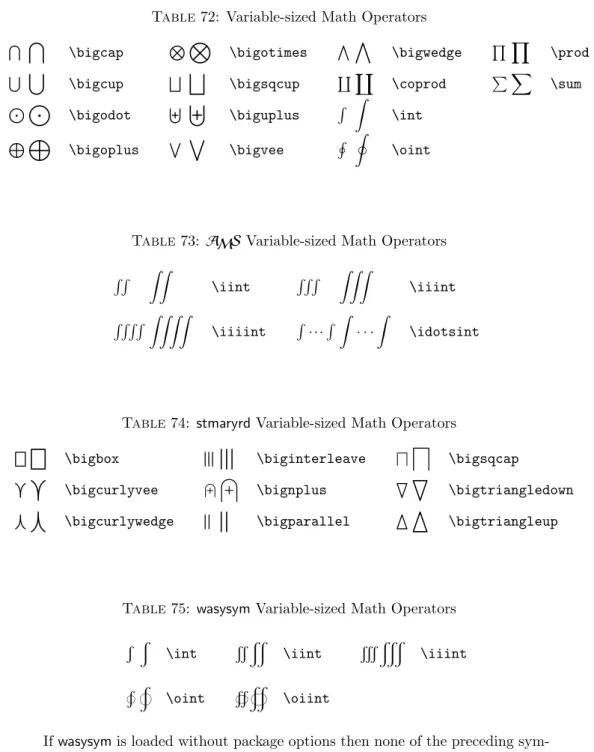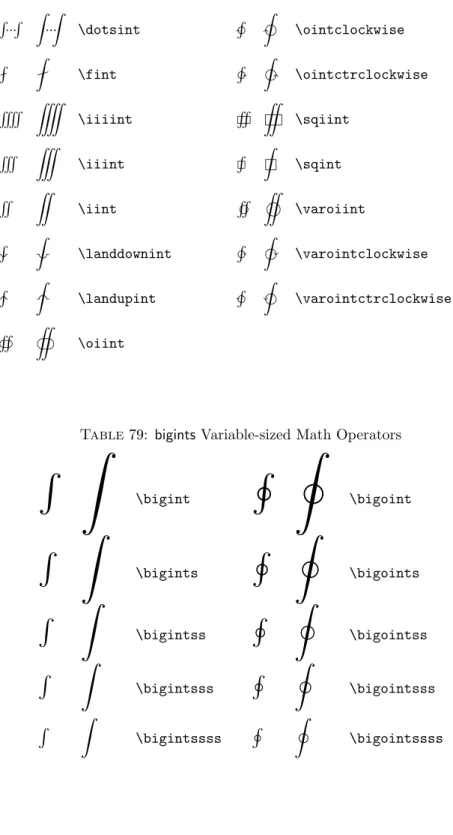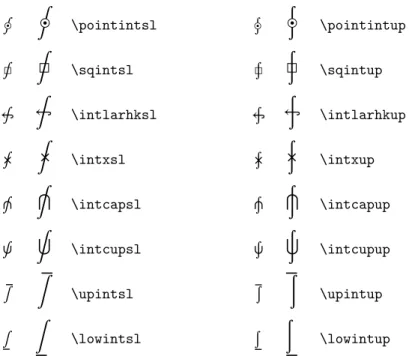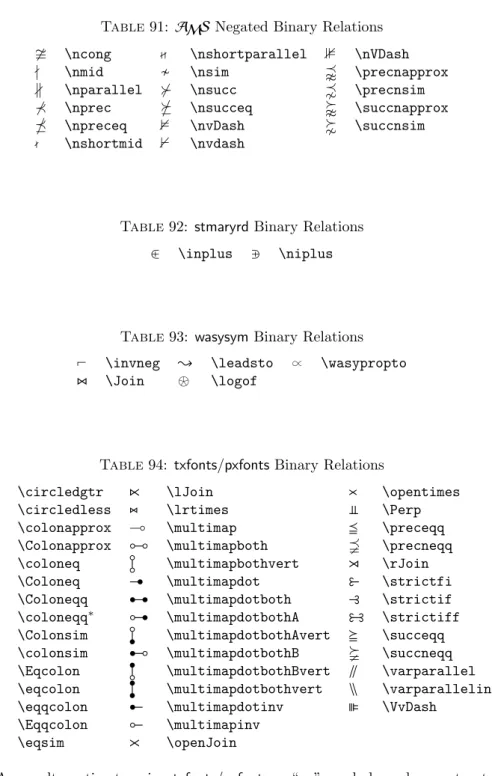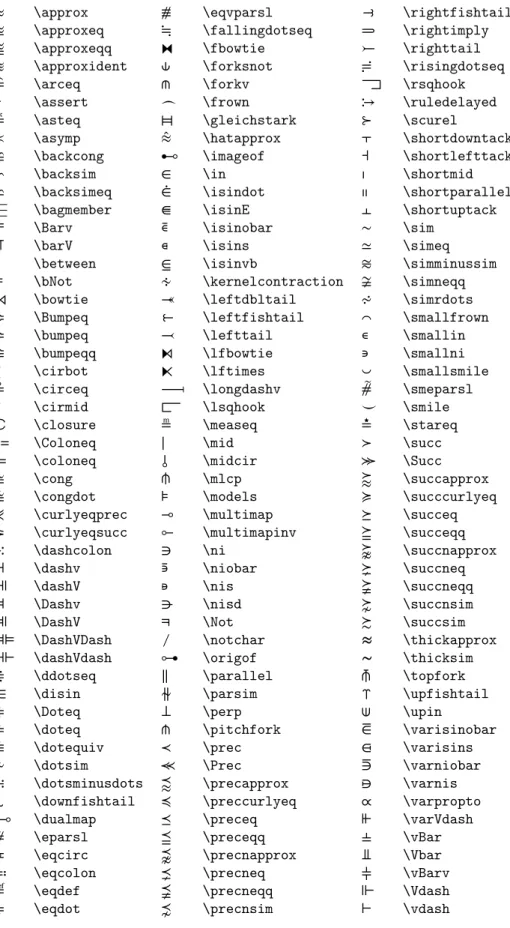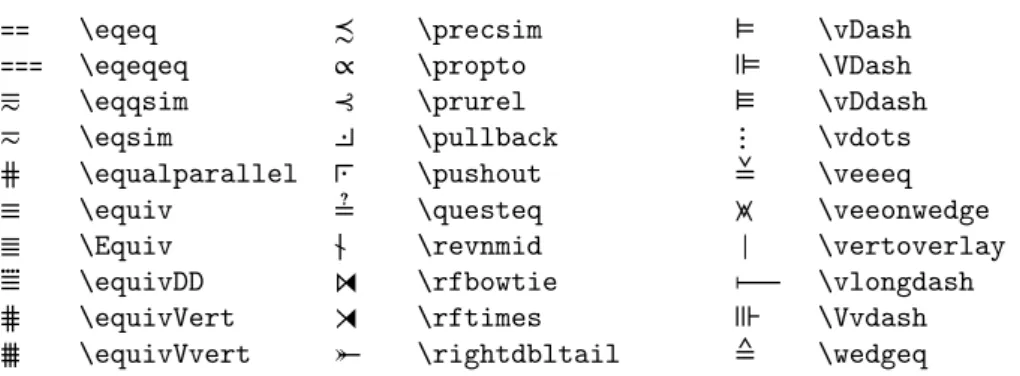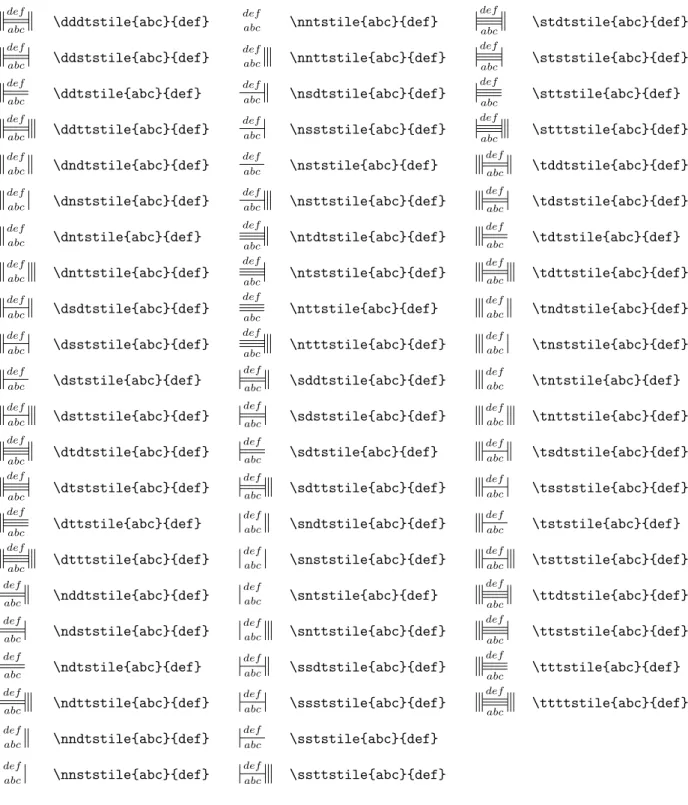The Comprehensive L A TEX Symbol List
Scott Pakin <scott+clsl@pakin.org>
∗5 May 2021
Abstract
This document lists 18150 symbols and the corresponding LATEX commands that produce them.
Some of these symbols are guaranteed to be available in every LATEX 2𝜀 system; others require fonts and packages that may not accompany a given distribution and that therefore need to be installed.
All of the fonts and packages used to prepare this document—as well as this document itself—are freely available from the Comprehensive TEX Archive Network (http://www.ctan.org/).
Contents
Contents 1
1 Introduction 13
1.1 Document Usage . . . 13
1.2 Frequently Requested Symbols . . . 14
2 Body-text symbols 15 Table 1: LATEX 2𝜀 Escapable “Special” Characters . . . 15
Table 2: Predefined LATEX 2𝜀 Text-mode Commands . . . 15
Table 3: LATEX 2𝜀 Commands Defined to Work in Both Math and Text Mode . . . 16
Table 4: 𝒜ℳ𝒮Commands Defined to Work in Both Math and Text Mode . . . 16
Table 5: Non-ASCII Letters (Excluding Accented Letters) . . . 16
Table 6: textgreek Upright Greek Letters . . . 16
Table 7: Letters Used to Typeset African Languages . . . 17
Table 8: Letters Used to Typeset Vietnamese . . . 17
Table 9: Punctuation Marks Not Found in OT1 . . . 17
Table 10: pifont Decorative Punctuation Marks . . . 17
Table 11: tipaPhonetic Symbols . . . 18
Table 12: tipxPhonetic Symbols . . . 19
Table 13: wsuipaPhonetic Symbols . . . 20
Table 14: wasysymPhonetic Symbols . . . 20
Table 15: phoneticPhonetic Symbols . . . 20
Table 16: t4phonetPhonetic Symbols . . . 21
Table 17: semtrans Transliteration Symbols . . . 21
Table 18: Text-mode Accents . . . 21
Table 19: tipaText-mode Accents . . . 22
Table 20: extraipaText-mode Accents . . . 23
Table 21: wsuipaText-mode Accents . . . 23
Table 22: phoneticText-mode Accents . . . 24
Table 23: metreText-mode Accents . . . 24
Table 24: t4phonetText-mode Accents . . . 24
Table 25: arcs Text-mode Accents . . . 24
Table 26: semtrans Accents . . . 25
Table 27: ogonekAccents . . . 25
∗The original version of this document was written by David Carlisle, with several additional tables provided by Alexan- der Holt. See Section 11.8 on page 275 for more information about who did what.
Table 28: combelowAccents . . . 25
Table 29: wsuipaDiacritics . . . 25
Table 30: textcompDiacritics . . . 25
Table 31: marvosymDiacritics . . . 26
Table 32: textcompCurrency Symbols . . . 26
Table 33: marvosymCurrency Symbols . . . 26
Table 34: fontawesomeCurrency Symbols . . . 26
Table 35: wasysymCurrency Symbols . . . 26
Table 36: ChinA2e Currency Symbols . . . 27
Table 37: teubnerCurrency Symbols . . . 27
Table 38: tfrupeeCurrency Symbols . . . 27
Table 39: eurosym Euro Signs . . . 27
Table 40: fourier Euro Signs . . . 27
Table 41: textcompLegal Symbols . . . 27
Table 42: fontawesomeLegal Symbols . . . 27
Table 43: cclicensesCreative Commons License Icons . . . 28
Table 44: ccicons Creative Commons License Icons . . . 28
Table 45: textcompOld-style Numerals . . . 28
Table 46: Miscellaneous textcompSymbols . . . 28
Table 47: Miscellaneous wasysymText-mode Symbols . . . 28
3 Mathematical symbols 30 Table 48: Math-mode Versions of Text Symbols . . . 30
Table 49: cmllUnary Operators . . . 30
Table 50: Binary Operators . . . 31
Table 51: 𝒜ℳ𝒮Binary Operators . . . 31
Table 52: stmaryrdBinary Operators . . . 31
Table 53: wasysymBinary Operators . . . 32
Table 54: txfonts/pxfontsBinary Operators . . . 32
Table 55: mathabxBinary Operators . . . 32
Table 56: MnSymbolBinary Operators . . . 32
Table 57: fdsymbolBinary Operators . . . 33
Table 58: boisikBinary Operators . . . 34
Table 59: stixBinary Operators . . . 35
Table 60: mathdesignBinary Operators . . . 35
Table 61: cmllBinary Operators . . . 36
Table 62: shuffleBinary Operators . . . 36
Table 63: ulsyGeometric Binary Operators . . . 36
Table 64: mathabxGeometric Binary Operators . . . 36
Table 65: MnSymbolGeometric Binary Operators . . . 37
Table 66: fdsymbolGeometric Binary Operators . . . 37
Table 67: boisikGeometric Binary Operators . . . 38
Table 68: stixGeometric Binary Operators . . . 39
Table 69: halloweenmathHalloween-Themed Math Operators . . . 39
Table 70: stixSmall Integrals . . . 40
Table 71: stixSmall Integrals with Explicit Slant . . . 40
Table 72: Variable-sized Math Operators . . . 41
Table 73: 𝒜ℳ𝒮Variable-sized Math Operators . . . 41
Table 74: stmaryrdVariable-sized Math Operators . . . 41
Table 75: wasysymVariable-sized Math Operators . . . 41
Table 76: mathabxVariable-sized Math Operators . . . 42
Table 77: txfonts/pxfontsVariable-sized Math Operators . . . 43
Table 78: esintVariable-sized Math Operators . . . 44
Table 79: bigintsVariable-sized Math Operators . . . 44
Table 80: MnSymbolVariable-sized Math Operators . . . 45
Table 81: fdsymbolVariable-sized Math Operators . . . 45
Table 82: boisikVariable-sized Math Operators . . . 46
Table 83: stixVariable-sized Math Operators . . . 47
Table 84: stixIntegrals with Explicit Slant . . . 48
Table 85: cmupintVariable-sized Upright Integrals . . . 49
Table 86: mathdesignVariable-sized Math Operators . . . 50
Table 87: prodintVariable-sized Math Operators . . . 51
Table 88: cmllLarge Math Operators . . . 51
Table 89: Binary Relations . . . 51
Table 90: 𝒜ℳ𝒮Binary Relations . . . 51
Table 91: 𝒜ℳ𝒮Negated Binary Relations . . . 52
Table 92: stmaryrdBinary Relations . . . 52
Table 93: wasysymBinary Relations . . . 52
Table 94: txfonts/pxfontsBinary Relations . . . 52
Table 95: txfonts/pxfontsNegated Binary Relations . . . 52
Table 96: mathabxBinary Relations . . . 53
Table 97: mathabxNegated Binary Relations . . . 53
Table 98: MnSymbolBinary Relations . . . 53
Table 99: MnSymbolNegated Binary Relations . . . 55
Table 100: fdsymbolBinary Relations . . . 56
Table 101: fdsymbolNegated Binary Relations . . . 57
Table 102: boisikBinary Relations . . . 58
Table 103: boisikNegated Binary Relations . . . 58
Table 104: stixBinary Relations . . . 59
Table 105: stixNegated Binary Relations . . . 60
Table 106: mathtoolsBinary Relations . . . 60
Table 107: turnstileBinary Relations . . . 61
Table 108: trsymBinary Relations . . . 62
Table 109: trfsigns Binary Relations . . . 62
Table 110: cmllBinary Relations . . . 62
Table 111: colonequals Binary Relations . . . 62
Table 112: fourier Binary Relations . . . 62
Table 113: Subset and Superset Relations . . . 62
Table 114: 𝒜ℳ𝒮Subset and Superset Relations . . . 63
Table 115: stmaryrdSubset and Superset Relations . . . 63
Table 116: wasysymSubset and Superset Relations . . . 63
Table 117: txfonts/pxfontsSubset and Superset Relations . . . 63
Table 118: mathabxSubset and Superset Relations . . . 63
Table 119: MnSymbolSubset and Superset Relations . . . 64
Table 120: fdsymbolSubset and Superset Relations . . . 64
Table 121: boisikSubset and Superset Relations . . . 64
Table 122: stixSubset and Superset Relations . . . 65
Table 123: Inequalities . . . 65
Table 124: 𝒜ℳ𝒮Inequalities . . . 65
Table 125: wasysymInequalities . . . 66
Table 126: txfonts/pxfontsInequalities . . . 66
Table 127: mathabxInequalities . . . 66
Table 128: MnSymbolInequalities . . . 67
Table 129: fdsymbolInequalities . . . 68
Table 130: boisikInequalities . . . 69
Table 131: stixInequalities . . . 69
Table 132: 𝒜ℳ𝒮Triangle Relations . . . 70
Table 133: stmaryrdTriangle Relations . . . 70
Table 134: mathabxTriangle Relations . . . 70
Table 135: MnSymbolTriangle Relations . . . 71
Table 136: fdsymbolTriangle Relations . . . 72
Table 137: boisikTriangle Relations . . . 72
Table 138: stixTriangle Relations . . . 72
Table 139: Arrows . . . 73
Table 140: Harpoons . . . 73
Table 141: textcompText-mode Arrows . . . 73
Table 142: 𝒜ℳ𝒮Arrows . . . 73
Table 143: 𝒜ℳ𝒮Negated Arrows . . . 73
Table 144: 𝒜ℳ𝒮Harpoons . . . 73
Table 145: stmaryrdArrows . . . 74
Table 146: txfonts/pxfontsArrows . . . 74
Table 147: mathabxArrows . . . 74
Table 148: mathabxNegated Arrows . . . 74
Table 149: mathabxHarpoons . . . 75
Table 150: MnSymbolArrows . . . 75
Table 151: MnSymbolNegated Arrows . . . 76
Table 152: MnSymbolHarpoons . . . 78
Table 153: MnSymbolNegated Harpoons . . . 78
Table 154: fdsymbolArrows . . . 79
Table 155: fdsymbolNegated Arrows . . . 80
Table 156: fdsymbolHarpoons . . . 82
Table 157: fdsymbolNegated Harpoons . . . 83
Table 158: boisikArrows . . . 83
Table 159: boisikNegated Arrows . . . 84
Table 160: boisikHarpoons . . . 84
Table 161: stixArrows . . . 85
Table 162: stixNegated Arrows . . . 87
Table 163: stixHarpoons . . . 87
Table 164: harpoonExtensible Harpoons . . . 88
Table 165: chemarrow Arrows . . . 88
Table 166: fgeArrows . . . 88
Table 167: old-arrowsArrows . . . 88
Table 168: old-arrowsHarpoons . . . 89
Table 169: esrelationRestrictions . . . 89
Table 170: MnSymbolSpoons . . . 89
Table 171: MnSymbolPitchforks . . . 89
Table 172: MnSymbolSmiles and Frowns . . . 90
Table 173: fdsymbolSpoons . . . 90
Table 174: fdsymbolPitchforks . . . 91
Table 175: fdsymbolSmiles and Frowns . . . 91
Table 176: halloweenmathBrooms and Pitchforks . . . 91
Table 177: ulsyContradiction Symbols . . . 91
Table 178: Extension Characters . . . 91
Table 179: stmaryrdExtension Characters . . . 91
Table 180: txfonts/pxfontsExtension Characters . . . 91
Table 181: mathabxExtension Characters . . . 92
Table 182: stixExtension Characters . . . 92
Table 183: Log-like Symbols . . . 92
Table 184: 𝒜ℳ𝒮Log-like Symbols . . . 92
Table 185: mismath Log-like Symbols . . . 93
Table 186: mismath Asymptotic Notation . . . 93
Table 187: ChinA2e Number Sets . . . 93
Table 188: Greek Letters . . . 94
Table 189: 𝒜ℳ𝒮Greek Letters . . . 94
Table 190: txfonts/pxfontsUpright Greek Letters . . . 95
Table 191: upgreekUpright Greek Letters . . . 95
Table 192: fourier Variant Greek Letters . . . 95
Table 193: txfonts/pxfontsVariant Latin Letters . . . 96
Table 194: boisikVariant Greek Letters . . . 96
Table 195: boisikVariant Latin Letters . . . 96
Table 196: stixVariant Greek Letters . . . 96
Table 197: stixTransformed Greek Letters . . . 96
Table 198: 𝒜ℳ𝒮Hebrew Letters . . . 96
Table 199: MnSymbolHebrew Letters . . . 96
Table 200: fdsymbolHebrew Letters . . . 96
Table 201: boisikHebrew Letters . . . 96
Table 202: stixHebrew Letters . . . 97
Table 203: Letter-like Symbols . . . 97
Table 204: 𝒜ℳ𝒮Letter-like Symbols . . . 97
Table 205: txfonts/pxfontsLetter-like Symbols . . . 97
Table 206: mathabxLetter-like Symbols . . . 97
Table 207: MnSymbolLetter-like Symbols . . . 97
Table 208: fdsymbolLetter-like Symbols . . . 98
Table 209: boisikLetter-like Symbols . . . 98
Table 210: stixLetter-like Symbols . . . 98
Table 211: trfsigns Letter-like Symbols . . . 98
Table 212: mathdesignLetter-like Symbols . . . 98
Table 213: fgeLetter-like Symbols . . . 98
Table 214: fourier Letter-like Symbols . . . 99
Table 215: cmllLetter-like Symbols . . . 99
Table 216: 𝒜ℳ𝒮Delimiters . . . 99
Table 217: stmaryrdDelimiters . . . 99
Table 218: mathabxDelimiters . . . 99
Table 219: boisikDelimiters . . . 99
Table 220: stixDelimiters . . . 99
Table 221: nathDelimiters . . . 99
Table 222: Variable-sized Delimiters . . . 100
Table 223: Large, Variable-sized Delimiters . . . 100
Table 224: 𝒜ℳ𝒮Variable-sized Delimiters . . . 100
Table 225: stmaryrdVariable-sized Delimiters . . . 100
Table 226: mathabxVariable-sized Delimiters . . . 101
Table 227: MnSymbolVariable-sized Delimiters . . . 101
Table 228: fdsymbolVariable-sized Delimiters . . . 102
Table 229: stixVariable-sized Delimiters . . . 103
Table 230: mathdesignVariable-sized Delimiters . . . 104
Table 231: nathVariable-sized Delimiters (Double) . . . 105
Table 232: nathVariable-sized Delimiters (Triple) . . . 105
Table 233: fourier Variable-sized Delimiters . . . 105
Table 234: textcompText-mode Delimiters . . . 105
Table 235: metreText-mode Delimiters . . . 106
Table 236: Math-mode Accents . . . 106
Table 237: 𝒜ℳ𝒮Math-mode Accents . . . 106
Table 238: MnSymbolMath-mode Accents . . . 106
Table 239: fdsymbolMath-mode Accents . . . 107
Table 240: boisikMath-mode Accents . . . 107
Table 241: stixMath-mode Accents . . . 107
Table 242: fgeMath-mode Accents . . . 107
Table 243: yhmathMath-mode Accents . . . 107
Table 244: halloweenmathHalloween-Themed Math-mode Accents . . . 107
Table 245: realhatsMath-mode Hat Accents . . . 108
Table 246: Extensible Accents . . . 108
Table 247: overrightarrowExtensible Accents . . . 108
Table 248: yhmathExtensible Accents . . . 109
Table 249: 𝒜ℳ𝒮Extensible Accents . . . 109
Table 250: MnSymbolExtensible Accents . . . 109
Table 251: fdsymbolExtensible Accents . . . 109
Table 252: stixExtensible Accents . . . 110
Table 253: mathtoolsExtensible Accents . . . 110
Table 254: mathabxExtensible Accents . . . 110
Table 255: fourier Extensible Accents . . . 110
Table 256: esvectExtensible Accents . . . 111
Table 257: abracesExtensible Accents . . . 111
Table 258: undertildeExtensible Accents . . . 111
Table 259: ushortExtensible Accents . . . 111
Table 260: mdwmathExtensible Accents . . . 111
Table 261: actuarialangleExtensible Accents . . . 112
Table 262: 𝒜ℳ𝒮Extensible Arrows . . . 112
Table 263: mathtoolsExtensible Arrows . . . 112
Table 264: chemarrExtensible Arrows . . . 112
Table 265: chemarrow Extensible Arrows . . . 112
Table 266: extarrowsExtensible Arrows . . . 113
Table 267: extpfeilExtensible Arrows . . . 113
Table 268: DotArrow Extensible Arrows . . . 113
Table 269: halloweenmathExtensible Arrows . . . 113
Table 270: trfsigns Extensible Transform Symbols . . . 113
Table 271: esrelationExtensible Relations . . . 114
Table 272: halloweenmathExtensible Brooms and Pitchforks . . . 114
Table 273: halloweenmathExtensible Witches . . . 114
Table 274: halloweenmathExtensible Ghosts . . . 115
Table 275: halloweenmathExtensible Bats . . . 115
Table 276: holtpoltNon-commutative Division Symbols . . . 115
Table 277: Dots . . . 115
Table 278: 𝒜ℳ𝒮Dots . . . 115
Table 279: wasysymDots . . . 116
Table 280: MnSymbolDots . . . 116
Table 281: fdsymbolDots . . . 116
Table 282: stixDots . . . 116
Table 283: mathdots Dots . . . 116
Table 284: yhmathDots . . . 117
Table 285: teubnerDots . . . 117
Table 286: begriff Begriffsschrift Symbols . . . 117
Table 287: frege Begriffsschrift Symbols . . . 117
Table 288: mathcompMath Symbols . . . 117
Table 289: marvosymMath Symbols . . . 117
Table 290: marvosymDigits . . . 118
Table 291: fgeDigits . . . 118
Table 292: dozenalBase-12 Digits . . . 118
Table 293: mathabxMayan Digits . . . 118
Table 294: stixInfinities . . . 118
Table 295: stixPrimes . . . 118
Table 296: stixEmpty Sets . . . 118
Table 297: 𝒜ℳ𝒮Angles . . . 118
Table 298: MnSymbolAngles . . . 118
Table 299: fdsymbolAngles . . . 119
Table 300: boisikAngles . . . 119
Table 301: stixAngles . . . 119
Table 302: Miscellaneous LATEX 2𝜀Math Symbols . . . 119
Table 303: Miscellaneous 𝒜ℳ𝒮Math Symbols . . . 120
Table 304: Miscellaneous wasysymMath Symbols . . . 120
Table 305: Miscellaneous txfonts/pxfontsMath Symbols . . . 120
Table 306: Miscellaneous mathabxMath Symbols . . . 120
Table 307: Miscellaneous MnSymbolMath Symbols . . . 120
Table 308: Miscellaneous InternalMnSymbolMath Symbols . . . 121
Table 309: Miscellaneous fdsymbolMath Symbols . . . 121
Table 310: Miscellaneous boisikMath Symbols . . . 121
Table 311: Miscellaneous stixMath Symbols . . . 122
Table 312: endofproofwd End-of-Proof Symbols . . . 122
Table 313: Miscellaneous textcompText-mode Math Symbols . . . 122
Table 314: Miscellaneous fgeMath Symbols . . . 123
Table 315: Miscellaneous mathdesignMath Symbols . . . 123
Table 316: Math Alphabets . . . 124
4 Science and technology symbols 126 Table 317: gensymbSymbols Defined to Work in Both Math and Text Mode . . . 126
Table 318: wasysymElectrical and Physical Symbols . . . 126
Table 319: ifsymPulse Diagram Symbols . . . 126
Table 320: arAspect Ratio Symbol . . . 126
Table 321: plimsollPlimsoll Symbol . . . 126
Table 322: textcompText-mode Science and Engineering Symbols . . . 126
Table 323: steinmetz Extensible Phasor Symbol . . . 127
Table 324: emf Electromotive Force Symbols . . . 127
Table 325: wasysymAstronomical Symbols . . . 127
Table 326: marvosymAstronomical Symbols . . . 127
Table 327: fontawesomeAstronomical Symbols . . . 128
Table 328: mathabxAstronomical Symbols . . . 128
Table 329: stixAstronomical Symbols . . . 128
Table 330: utfsymAstronomical Symbols . . . 128
Table 331: starfontAstronomical Symbols . . . 129
Table 332: wasysymAPL Symbols . . . 129
Table 333: stixAPL Symbols . . . 129
Table 334: apl APL Symbols . . . 130
Table 335: marvosymComputer Hardware Symbols . . . 130
Table 336: keystrokeComputer Keys . . . 130
Table 337: asciiControl Characters (CP437) . . . 131
Table 338: logicLogic Gates . . . 131
Table 339: marvosymCommunication Symbols . . . 131
Table 340: marvosymEngineering Symbols . . . 132
Table 341: wasysymBiological Symbols . . . 132
Table 342: stixBiological Symbols . . . 132
Table 343: marvosymBiological Symbols . . . 132
Table 344: utfsymBiological Symbols . . . 132
Table 345: fontawesomeBiological Symbols . . . 132
Table 346: marvosymSafety-related Symbols . . . 133
Table 347: feynFeynman Diagram Symbols . . . 133
Table 348: svrsymbolsPhysics Ideograms . . . 133
5 Dingbats 135 Table 349: bbding Arrows . . . 135
Table 350: pifont Arrows . . . 135
Table 351: adfsymbolsArrows . . . 135
Table 352: adforn Arrows . . . 136
Table 353: arev Arrows . . . 136
Table 354: utfsymArrows . . . 136
Table 355: fontawesomeArrows . . . 136
Table 356: fontawesomeChevrons . . . 136
Table 357: marvosymScissors . . . 137
Table 358: bbding Scissors . . . 137
Table 359: pifont Scissors . . . 137
Table 360: utfsymScissors . . . 137
Table 361: dingbatPencils . . . 137
Table 362: arev Pencils . . . 137
Table 363: fontawesomePencils . . . 137
Table 364: bbding Pencils and Nibs . . . 137
Table 365: pifont Pencils and Nibs . . . 138
Table 366: utfsymPencils, Pens, and Nibs . . . 138
Table 367: dingbatFists . . . 138
Table 368: bbding Fists . . . 138
Table 369: pifont Fists . . . 138
Table 370: fourier Fists . . . 138
Table 371: arev Fists . . . 138
Table 372: utfsymFists . . . 139
Table 373: fontawesomeFists . . . 139
Table 374: bbding Crosses and Plusses . . . 139
Table 375: pifont Crosses and Plusses . . . 139
Table 376: adfsymbolsCrosses and Plusses . . . 139
Table 377: utfsymCrosses and Plusses . . . 140
Table 378: arev Crosses . . . 140
Table 379: bbding Xs and Check Marks . . . 140
Table 380: pifont Xs and Check Marks . . . 140
Table 381: wasysymXs and Check Marks . . . 140
Table 382: marvosymXs and Check Marks . . . 140
Table 383: arev Xs and Check Marks . . . 140
Table 384: utfsymXs and Check Marks . . . 141
Table 385: fontawesomeXs and Check Marks . . . 141
Table 386: pifont Circled Numerals . . . 141
Table 387: utfsymCircled Numerals . . . 141
Table 388: wasysymStars . . . 142
Table 389: bbding Stars, Flowers, and Similar Shapes . . . 142
Table 390: pifont Stars, Flowers, and Similar Shapes . . . 142
Table 391: adfsymbolsStars, Flowers, and Similar Shapes . . . 142
Table 392: utfsymStars, Flowers, and Similar Shapes . . . 143
Table 393: adforn Stars . . . 143
Table 394: fontawesomeStars . . . 143
Table 395: fourier Fleurons and Flowers . . . 143
Table 396: adforn Fleurons and Flowers . . . 144
Table 397: wasysymGeometric Shapes . . . 144
Table 398: MnSymbolGeometric Shapes . . . 144
Table 399: fdsymbolGeometric Shapes . . . 144
Table 400: boisikGeometric Shapes . . . 145
Table 401: stixGeometric Shapes . . . 145
Table 402: ifsymGeometric Shapes . . . 146
Table 403: bbding Geometric Shapes . . . 147
Table 404: pifont Geometric Shapes . . . 147
Table 405: universaGeometric Shapes . . . 147
Table 406: adfsymbolsGeometric Shapes . . . 147
Table 407: utfsymGeometric Shapes . . . 148
Table 408: fontawesomeGeometric Shapes . . . 148
Table 409: oplotsymbl Geometric Shapes . . . 148
Table 410: adforn Flourishes . . . 149
Table 411: Miscellaneous oplotsymblSymbols . . . 149
Table 412: Miscellaneous dingbatDingbats . . . 149
Table 413: Miscellaneous bbdingDingbats . . . 149
Table 414: Miscellaneous pifontDingbats . . . 150
Table 415: Miscellaneous adfornDingbats . . . 150
Table 416: Miscellaneous utfsymDingbats . . . 150
6 Ancient languages 151 Table 417: phaistosSymbols from the Phaistos Disk . . . 151
Table 418: protosemProto-Semitic Characters . . . 151
Table 419: hieroglf Hieroglyphics . . . 152
Table 420: linearA Linear A Script . . . 152
Table 421: linearbLinear B Basic and Optional Letters . . . 155
Table 422: linearbLinear B Numerals . . . 155
Table 423: linearbLinear B Weights and Measures . . . 155
Table 424: linearbLinear B Ideograms . . . 156
Table 425: linearbUnidentified Linear B Symbols . . . 156
Table 426: cypriot Cypriot Letters . . . 156
Table 427: sarabianSouth Arabian Letters . . . 157
Table 428: teubnerArchaic Greek Letters and Greek Numerals . . . 157
Table 429: boisikArchaic Greek Letters and Greek Numerals . . . 157
Table 430: epiolmecEpi-Olmec Script . . . 157
Table 431: epiolmecEpi-Olmec Numerals . . . 159
Table 432: allrunes Runes . . . 160
Table 433: allrunes Rune Separators . . . 160
7 Musical symbols 161 Table 434: LATEX 2𝜀 Musical Symbols . . . 161
Table 435: textcompMusical Symbols . . . 161
Table 436: wasysymMusical Symbols . . . 161
Table 437: MnSymbolMusical Symbols . . . 161
Table 438: fdsymbolMusical Symbols . . . 161
Table 439: boisikMusical Symbols . . . 161
Table 440: stixMusical Symbols . . . 161
Table 441: arev Musical Symbols . . . 161
Table 442: utfsymMusical Symbols . . . 162
Table 443: MusiXTEX Musical Symbols . . . 162
Table 444: MusiXTEX Alternative Clefs . . . 163
Table 445: harmonyMusical Symbols . . . 163
Table 446: musicography Musical Symbols . . . 164
Table 447: musicography Time Signatures . . . 164
Table 448: harmonyMusical Accents . . . 164
Table 449: lilyly
p s
Single Notes . . . 165Table 450: lilyly
p s
Beamed Notes . . . 165Table 451: lilyly
p s
Clefs . . . 166Table 452: lilyly
p s
Time Signatures . . . 166Table 453: lilyly
p s
Accidentals . . . 166Table 454: lilyly
p s
Rests . . . 166Table 455: lilyly
p s
Dynamics Letters . . . 167Table 456: lilyly
p s
Dynamics Symbols . . . 167Table 457: lilyly
p s
Articulations . . . 167Table 458: lilyly
p s
Scripts . . . 167Table 459: lilyly
p s
Accordion Notation . . . 167Table 460: lilyly
p s
Named Time Signatures . . . 168Table 461: lilyly
p s
Named Scripts . . . 168Table 462: lilyly
p s
Named Rests . . . 169Table 463: lilyly
p s
Named Pedals . . . 169Table 464: lilyly
p s
Named Flags . . . 170Table 465: lilyly
p s
Named Custodes . . . 170Table 466: lilyly
p s
Named Clefs . . . 171Table 467: lilyly
p s
Named Noteheads . . . 172Table 468: lilyly
p s
Named Accordion Symbols . . . 176Table 469: lilyly
p s
Named Accidentals . . . 177Table 470: lilyly
p s
Named Arrowheads . . . 177Table 471: lilyly
p s
Named Alphanumerics and Punctuation . . . 178Table 472: Miscellaneous lilyly
p s
Named Musical Symbols . . . 1788 Gaming symbols 179
Table 473: LATEX 2𝜀 Playing-Card Suits . . . 179
Table 474: txfonts/pxfontsPlaying-Card Suits . . . 179
Table 475: MnSymbolPlaying-Card Suits . . . 179
Table 476: fdsymbolPlaying-Card Suits . . . 179
Table 477: boisikPlaying-Card Suits . . . 179
Table 478: stixPlaying-Card Suits . . . 179
Table 479: arev Playing-Card Suits . . . 179
Table 480: twemojisPlaying-Card Suits . . . 179
Table 481: utfsymPlaying-Card Suits . . . 180
Table 482: utfsymPlaying Cards . . . 180
Table 483: epsdiceDice . . . 180
Table 484: hhcount Dice . . . 181
Table 485: stixDice . . . 181
Table 486: ifsymDice . . . 181
Table 487: utfsymDice . . . 181
Table 488: utfsymDomino Tiles . . . 181
Table 489: utfsymMahjong Tiles . . . 182
Table 490: utfsymChess Pieces . . . 183
Table 491: skakChess Informator Symbols . . . 183
Table 492: skakChess Pieces and Chessboard Squares . . . 184
Table 493: igoGo Symbols . . . 184
Table 494: goGo Symbols . . . 185
9 Other symbols 186 Table 495: textcompGenealogical Symbols . . . 186
Table 496: wasysymGeneral Symbols . . . 186
Table 497: utfsymTransportation Symbols . . . 186
Table 498: twemojisTransportation Emoji . . . 187
Table 499: manfnt Dangerous Bend Symbols . . . 188
Table 500: Miscellaneous manfntSymbols . . . 188
Table 501: marvosymMedia Control Symbols . . . 188
Table 502: marvosymLaundry Symbols . . . 189
Table 503: marvosymInformation Symbols . . . 189
Table 504: OthermarvosymSymbols . . . 189
Table 505: Miscellaneous universaSymbols . . . 189
Table 506: Miscellaneous fourierSymbols . . . 189
Table 507: utfsymWeather Symbols . . . 189
Table 508: twemojisWeather Symbols . . . 190
Table 509: ifsymWeather Symbols . . . 190
Table 510: ifsymAlpine Symbols . . . 190
Table 511: ifsymClocks . . . 190
Table 512: utfsymClocks . . . 191
Table 513: clockClocks . . . 191
Table 514: twemojisClocks . . . 191
Table 515: twemojisAnimals . . . 192
Table 516: twemojisFood Emoji . . . 193
Table 517: hhcount Tally Markers . . . 194
Table 518: ifsymTally Markers . . . 194
Table 519: bullcntr Tally Markers . . . 195
Table 520: dozenalTally Markers . . . 195
Table 521: skullSymbols . . . 195
Table 522: Non-MathematicalmathabxSymbols . . . 195
Table 523: OtherifsymSymbols . . . 196
Table 524: metreMetrical Symbols . . . 196
Table 525: metreSmall and Large Metrical Symbols . . . 196
Table 526: teubnerMetrical Symbols . . . 196
Table 527: dictsymDictionary Symbols . . . 197
Table 528: simpsonsCharacters fromThe Simpsons . . . 197
Table 529: pmboxdraw Box-Drawing Symbols . . . 198
Table 530: stavesMagical Staves . . . 198
Table 531: pigpen Cipher Symbols . . . 199
Table 532: ChinA2e Phases of the Moon . . . 199
Table 533: twemojisPhases of the Moon . . . 200
Table 534: ChinA2e Recycling Symbols . . . 200
Table 535: marvosymRecycling Symbols . . . 200
Table 536: utfsymRecycling Symbols . . . 200
Table 537: recycleRecycling Symbols . . . 201
Table 538: OtherChinA2eSymbols . . . 201
Table 539: soyomboSoyombo Symbols . . . 201
Table 540: knitting Knitting Symbols . . . 202
Table 541: countriesofeuropeCountry Maps . . . 202
Table 542: rojudMaps of Romanian Counties . . . 204
Table 543: euflag European Union Flag . . . 206
Table 544: worldflagsWorld Flags . . . 206
Table 545: twemojisFlags . . . 208
Table 546: Miscellaneous arevSymbols . . . 211
Table 547: cookingsymbols Cooking Symbols . . . 211
Table 548: tikzsymbolsCooking Symbols . . . 211
Table 549: tikzsymbolsEmoji . . . 212
Table 550: tikzsymbols3D Emoji . . . 212
Table 551: utfsymEmoji . . . 213
Table 552: tikzsymbolsTrees . . . 213
Table 553: Miscellaneous tikzsymbolsSymbols . . . 213
Table 554: Miscellaneous twemojisEmoji . . . 214
Table 555: scsnowmanSnowmen . . . 226
Table 556: Miscellaneous bclogoSymbols . . . 227
Table 557: Miscellaneous utfsymPictographs . . . 228
Table 558: fontawesomeWeb-Related Icons . . . 231
Table 559: rubikcubeRubik’s Cube Rotations . . . 235
10 Fonts with minimal LATEX support 236 Table 560: handsFists . . . 236
Table 561: greenpointRecycling Symbols . . . 236
Table 562: nkartaMap Symbols . . . 236
Table 563: moonphaseAstronomical Symbols . . . 238
Table 564: astrosym Astronomical Symbols . . . 238
Table 565: webomints Decorative Borders . . . 241
Table 566: umrandaDecorative Borders . . . 242
Table 567: umrandbDecorative Borders . . . 243
Table 568: dingbatDecorative Borders . . . 244
Table 569: knotCeltic Knots . . . 244
Table 570: dancersDancing Men . . . 248
Table 571: semaphor Semaphore Alphabet . . . 250
Table 572: crystCrystallography Symbols . . . 252
Table 573: diceDice . . . 253
Table 574: magicTrading Card Symbols . . . 254
Table 575: bartel-chess-fontsChess Pieces and Chessboard Squares . . . 254
11 Additional Information 256 11.1 Symbol Name Clashes . . . 256
11.2 Resizing symbols . . . 256
11.3 Where can I find the symbol for . . . ? . . . 256
11.4 Math-mode spacing . . . 269
11.5 Bold mathematical symbols . . . 270
11.6 ASCII and Latin 1 quick reference . . . 270
11.7 Unicode characters . . . 272 11.8 About this document . . . 275 11.9 Copyright and license . . . 277
References 278
Index 279
1 Introduction
Welcome to the Comprehensive LATEX Symbol List! This document strives to be your primary source of LATEX symbol information: font samples, LATEX commands, packages, usage details, caveats—everything needed to put thousands of different symbols at your disposal. All of the fonts covered herein meet the following criteria:
1. They are freely available from the Comprehensive TEX Archive Network (http://www.ctan.org/).
2. All of their symbols have LATEX 2𝜀 bindings. That is, a user should be able to access a symbol by name (e.g., \bigtriangleup)
As of version 12 of the Comprehensive LATEX Symbol List, that second restriction has been relaxed with the inclusion of Section 10, which showcases fonts that provide, at a minimum, either TEX font-metric files (.tfm) or theMETAFONTsources (.mf) that produce those font-metric files. Some of the Section 10 fonts do include LATEX font-definition files (.fd). However, what sets the fonts in Section 10 apart from the fonts in rest of the document is that they lack a LATEX style file (.sty) that individually names each of the glyphs.
The restrictions listed above are not particularly limiting criteria; the Comprehensive LATEX Symbol List contains samples of 18150 symbols—quite a large number. Some of these symbols are guaran- teed to be available in every LATEX 2𝜀 system; others require fonts and packages that may not ac- company a given distribution and that therefore need to be installed. See http://www.tex.ac.uk/
FAQ-installthings.html for help with installing new fonts and packages.
1.1 Document Usage
Each section of this document contains a number of font tables. Each table shows a set of symbols, with the corresponding LATEX command to the right of each symbol. A table’s caption indicates what package needs to be loaded in order to access that table’s symbols. For example, the symbols in Ta- ble 45, “textcomp Old-Style Numerals”, are made available by putting “\usepackage{textcomp}” in your document’s preamble. “𝒜ℳ𝒮” means to use the 𝒜ℳ𝒮 packages, viz. amssymb and/or amsmath.
Notes below a table provide additional information about some or all the symbols in that table.
One note that appears a few times in this document, particularly in Section 2, indicates that certain symbols do not exist in the OT1 font encoding (Donald Knuth’s original, 7-bit font encoding, which is the default font encoding for LATEX) and that you should usefontencto select a different encoding, such as T1 (a common 8-bit font encoding). That means that you should put “\usepackage[⟨encoding⟩]{fontenc}” in your document’s preamble, where⟨encoding⟩is, e.g.,T1or LY1. To limit the change in font encoding to the current group, use “\fontencoding{⟨encoding⟩}\selectfont”.
Section 11 contains some additional information about the symbols in this document. It discusses how certain mathematical symbols can vary in height, shows which symbol names are not unique across packages, gives examples of how to create new symbols out of existing symbols, explains how symbols are spaced in math mode, compares various schemes for boldfacing symbols, presents LATEX ASCII and Latin 1 tables, shows how to input and output Unicode characters, and provides some information about this document itself. The Comprehensive LATEX Symbol List ends with an index of all the symbols in the document and various additional useful terms.
A companion document, Raw Font Tables, also presents a large number of symbols but with a very different structure from this document. Raw Font Tables includes only symbols produced via a font file, while this document also includes composite symbols (combinations of two or more glyphs) and symbols drawn as pictures (using, e.g., TikZ). This document sorts symbols by category while Raw Font Tables sorts symbols by underlying font file. The two documents are intended to complement each other. It is usually easier to find a desired symbol in The Comprehensive LATEX Symbol List, but Raw Font Tables is helpful for identifying related symbols, for finding symbols that exist in some font but are not exposed to the user via a LATEX package (or that this document inadvertently overlooked), and for the font name and character position needed to typeset a single symbol in isolation. The last of those is especially important for math symbols. TEX imposes a limitation of at most 16 math alphabets per document, but symbols typeset with\font and\char are text symbols and do not consume a math alphabet. (They are less convenient to use within a mathematical expression, however.)
1.2 Frequently Requested Symbols
There are a number of symbols that are requested over and over again on comp.text.tex. If you’re looking for such a symbol the following list will help you find it quickly.
, as in “Spaces are significant.” . . . 15
¯ı, ˜ı, ˝ı, ˘ı, ˇı, etc. (versus ¯i, ˜i, ˝i, ˘i, and ˇi) . . 21
¢ . . . 26
e . . . 26
©,®, and ™ . . . 27
‰ . . . 28
. . . 43
∴ . . . 51
BandF . . . 52
.and& . . . 65
. .. . . . 116
°, as in “180°” or “15℃” . . . 122
ℒ,ℱ, etc. . . 124
N,Z, R, etc. . . 124
r
. . . 124−∫︀ . . . 262
´¯ a, `^e, etc. (i.e., several accents per character) 264 <, >, and| (instead of ¡, ¿, and —) . . . 270
^ and ˜ (or∼) . . . 271
2 Body-text symbols
This section lists symbols that are intended for use in running text, such as punctuation marks, accents, ligatures, and currency symbols.
Table1: LATEX 2𝜀Escapable “Special” Characters
$ \$ % \% \_* } \} & \& # \# { \{
*Theunderscore package redefines “_” to produce an underscore in text mode (i.e., it makes it unnecessary to escape the underscore character).
Table2: Predefined LATEX 2𝜀 Text-mode Commands
^ \textasciicircum* < \textless
˜ \textasciitilde* a ª \textordfeminine
* ∗ \textasteriskcentered o º \textordmasculine
∖ \textbackslash ¶ ¶ \textparagraph†
| \textbar · · \textperiodcentered
‖ ‖ \textbardbl % ‱ \textpertenthousand
○ ○ \textbigcircle % ‰ \textperthousand
{ \textbraceleft† ¿ \textquestiondown
} \textbraceright† “ \textquotedblleft
∙ • \textbullet ” \textquotedblright
○c © \textcopyright† ‘ \textquoteleft
† † \textdagger† ’ \textquoteright
‡ ‡ \textdaggerdbl† ○r ® \textregistered
$ $ \textdollar† S § \textsection†
. . . \textellipsis† $ £ \textsterling†
— \textemdash TM ™ \texttrademark
– \textendash \textunderscore†
¡ \textexclamdown \textvisiblespace
> \textgreater
The first symbol column represents the—sometimes “faked”—symbol that LATEX 2𝜀provides by default. The second symbol column represents the sym- bol as redefined bytextcomp(iftextcompredefines it). The textcomppackage is generally required to typeset Table 2’s symbols in italic, and some symbols additionally require the T1 font encoding for italic.
*\^{} and \~{} can be used instead of \textasciicircum and
\textasciitilde. See the discussion of “˜” on page 271.
†It’s generally preferable to use the corresponding symbol from Table 3 on the following page because the symbols in that table work properly in both text mode and math mode.
Table3: LATEX 2𝜀Commands Defined to Work in Both Math and Text Mode
{ \{ \_ ‡ ‡ \ddag £ \pounds
} \} ○c © \copyright . . . \dots S § \S
$ $ \$ † † \dag ¶ ¶ \P
The first symbol column represents the—sometimes “faked”—symbol that LATEX 2𝜀 provides by default. The second symbol column represents the sym- bol as redefined bytextcomp(iftextcompredefines it). Thetextcomppackage is generally required to typeset Table 3’s symbols in italic, and some symbols additionally require the T1 font encoding for italic.
Table 4: 𝒜ℳ𝒮Commands Defined to Work in Both Math and Text Mode X \checkmark r \circledR z \maltese
Table5: Non-ASCII Letters (Excluding Accented Letters)
˚a \aa Ð \DH* L \L ø \o þ \th*
˚A \AA Ð \DJ* l \l œ \oe Þ \TH*
Æ \AE đ \dj* Ŋ \NG* Œ \OE
æ \ae IJ \IJ ŋ \ng* ß \ss
ð \dh* ij \ij Ø \O SS \SS
*Not available in the OT1 font encoding. Use thefontenc package to select an alternate font encoding, such as T1.
Table6: textgreek Upright Greek Letters
α \textalpha η \texteta ν \textnu τ \texttau β \textbeta θ \texttheta ξ \textxi υ \textupsilon γ \textgamma ι \textiota ο \textomikron φ \textphi δ \textdelta κ \textkappa π \textpi χ \textchi ε \textepsilon λ \textlambda ρ \textrho ψ \textpsi ζ \textzeta μ \textmu* σ \textsigma ω \textomega Α \textAlpha Η \textEta Ν \textNu Τ \textTau Β \textBeta Θ \textTheta Ξ \textXi Υ \textUpsilon Γ \textGamma Ι \textIota Ο \textOmikron Φ \textPhi Δ \textDelta Κ \textKappa Π \textPi Χ \textChi Ε \textEpsilon Λ \textLambda Ρ \textRho Ψ \textPsi Ζ \textZeta Μ \textMu Σ \textSigma Ω \textOmega
*Synonyms for\textmuinclude\textmicro and\textmugreek.
textgreek tries to use a Greek font that matches the body text. As a result, the glyphs may appear slightly different from the above.
Unlikeupgreek(Table 191 on page 95),textgreek works in text mode.
The symbols in this table are intended to be used sporadically throughout a document (e.g., in phrases such as “β-decay”). In contrast, Greek body text can be typeset using the babel package’sgreek (or polutonikogreek) option—
and, of course, a font that provides the glyphs for the Greek alphabet.
Table 7: Letters Used to Typeset African Languages
Ð \B{D} ° \m{c} ¤ \m{f} ¨ \m{k} » \M{t} \m{Z}
\B{d} \m{D} \m{F} \m{N} \M{T} Â \T{E}
\B{H} ð \M{d} \m{G} \m{n} º \m{t} â \T{e}
§ \B{h} Ð \M{D} ¦ \m{g} ª \m{o} \m{T} Å \T{O}
· \B{t} ¡ \m{d} À \m{I} \m{O} ® \m{u}* å \T{o}
\B{T} \m{E} à \m{i} \m{P} \m{U}* \m{b} ¢ \m{e} \m{J} ± \m{p} \m{Y}
\m{B} \M{E} © \m{j} ¬ \m{s} ¯ \m{y}
\m{C} £ \M{e} \m{K} \m{S} ¶ \m{z}
These characters all need the T4 font encoding, which is provided by the fc package.
*\m{v}and\m{V} are synonyms for\m{u}and\m{U}.
Table 8: Letters Used to Typeset Vietnamese Ơ \OHORN ơ \ohorn Ư \UHORN ư \uhorn
These characters all need the T5 font encoding, which is provided by thevntex package.
Table9: Punctuation Marks Not Found in OT1
« \guillemetleft* ‹ \guilsinglleft „ \quotedblbase " \textquotedbl
» \guillemetright* › \guilsinglright ‚ \quotesinglbase
*Older versions of LATEX misspelled these as \guillemotleft and
\guillemotright. The older names are still retained for backward compati- bility.
To get these symbols, use thefontenc package to select an alternate font en- coding, such as T1.
Table10: pifontDecorative Punctuation Marks
{ \ding{123} } \ding{125} ¡ \ding{161} £ \ding{163}
| \ding{124} ~ \ding{126} ¢ \ding{162}
Table11: tipaPhonetic Symbols
È \textbabygamma P \textglotstop ï \textrtailn
b \textbarb ; \texthalflength ó \textrtailr
c \textbarc ż \texthardsign ù \textrtails
d \textbard # \texthooktop ú \textrtailt
é \textbardotlessj á \texthtb ü \textrtailz
g \textbarg ê \texthtbardotlessj $ \textrthook
Ü \textbarglotstop Á \texthtc À \textsca
1 \textbari â \texthtd à \textscb
ł \textbarl ä \texthtg ď \textsce
8 \textbaro H \texthth å \textscg
Ý \textbarrevglotstop Ê \texththeng Ë \textsch
0 \textbaru Î \texthtk @ \textschwa
ì \textbeltl Ò \texthtp I \textsci
β \textbeta Ó \texthtq ĺ \textscj
ò \textbullseye č \texthtrtaild Ï \textscl
\textceltpal É \texthtscg ð \textscn
χ \textchi Ö \texthtt Œ \textscoelig
Å \textcloseepsilon ß \texthvlig ś \textscomega Ñ \textcloseomega Û \textinvglotstop ö \textscr Æ \textcloserevepsilon K \textinvscr A \textscripta
Þ \textcommatailz ι \textiota g \textscriptg
^ \textcorner λ \textlambda V \textscriptv
ă \textcrb : \textlengthmark Ú \textscu
ą \textcrd ş \textlhookt Y \textscy
g \textcrg ę \textlhtlongi \textsecstress
è \textcrh ű \textlhtlongy ž \textsoftsign
Û \textcrinvglotstop Ô \textlonglegr  \textstretchc
ň \textcrlambda ¡ \textlptr tC \texttctclig
2 \textcrtwo M \textltailm Ù \textteshlig
C \textctc ñ \textltailn θ \texttheta
ć \textctd ë \textltilde þ \textthorn
ćý \textctdctzlig Ð \textlyoghlig £ \texttoneletterstem š \textctesh Í \textObardotlessj ţ \texttslig
J \textctj ŋ \textOlyoghlig 5 \textturna
ő \textctn ω \textomega ŕ \textturncelig
ť \textctt _ \textopencorner 4 \textturnh
ťC \textcttctclig O \textopeno ľ \textturnk
ÿ \textctyogh % \textpalhook Õ \textturnlonglegr
ý \textctz φ \textphi W \textturnm
dý \textdctzlig | \textpipe î \textturnmrleg
S \textdoublebaresh " \textprimstress ô \textturnr } \textdoublebarpipe ij \textraiseglotstop õ \textturnrrtail
=/ \textdoublebarslash ğ \textraisevibyi 6 \textturnscripta { \textdoublepipe 7 \textramshorns Ø \textturnt Ş \textdoublevertline \ \textrevapostrophe 2 \textturnv
Ť \textdownstep 9 \textreve û \textturnw
à \textdyoghlig 3 \textrevepsilon L \textturny dz \textdzlig Q \textrevglotstop υ \textupsilon
ε \textepsilon ź \textrevyogh Ţ \textupstep
S \textesh Ç \textrhookrevepsilon Š \textvertline R \textfishhookr Ä \textrhookschwa ğ \textvibyi
(continued on next page)
(continued from previous page)
ě \textg ~ \textrhoticity ů \textvibyy
γ \textgamma ¿ \textrptr ß \textwynn
Ů \textglobfall ã \textrtaild Z \textyogh
Ű \textglobrise í \textrtaill
tipadefines shortcut characters for many of the above. It also defines a com- mand \tone for denoting tone letters (pitches). See the tipa documentation for more information.
Table 12: tipx Phonetic Symbols
" \textaolig 3 \texthtbardotlessjvar ´ \textrthooklong B \textbenttailyogh ; \textinvomega q \textscaolig . \textbktailgamma p \textinvsca r \textscdelta D \textctinvglotstop ! \textinvscripta s \textscf 2 \textctjvar I \textlfishhookrlig t \textsck
% \textctstretchc # \textlhookfour w \textscm
& \textctstretchcvar < \textlhookp x \textscp
@ \textctturnt 1 \textlhti y \textscq
) \textdblig > \textlooptoprevesh ˝ \textspleftarrow H \textdoublebarpipevar 6 \textnrleg $ \textstretchcvar G \textdoublepipevar 9 \textObullseye ˙ \textsubdoublearrow ˇ \textdownfullarrow ˆ \textpalhooklong ¯ \textsubrightarrow 7 \textfemale ˜ \textpalhookvar P \textthornvari
5 \textfrbarn F \textpipevar Q \textthornvarii
’ \textfrhookd = \textqplig R \textthornvariii
( \textfrhookdvar ¨ \textrectangle S \textthornvariv
? \textfrhookt ˚ \textretractingvar E \textturnglotstop - \textfrtailgamma v \textrevscl u \textturnsck T \textglotstopvari z \textrevscr { \textturnscu U \textglotstopvarii \textrhooka C \textturnthree V \textglotstopvariii * \textrhooke A \textturntwo , \textgrgamma + \textrhookepsilon 8 \textuncrfemale
0 \textheng : \textrhookopeno ˘ \textupfullarrow
4 \texthmlig / \textrtailhth
Table13: wsuipaPhonetic Symbols
! \babygamma 8 \eng 4 \labdentalnas \schwa
\barb \er / \latfric * \sci
\bard M \esh 6 \legm : \scn
' \bari \eth E \legr J \scr
. \barl D \flapr 1 \lz \scripta
< \baro b \glotstop \nialpha \scriptg
A \barp \hookb \nibeta Y \scriptv
+ \barsci \hookd [ \nichi W \scu
X \barscu \hookg \niepsilon ] \scy
T \baru $ \hookh \nigamma \slashb
; \clickb % \hookheng ) \niiota \slashc
\clickc \hookrevepsilon 2 \nilambda \slashd
R \clickt " \hv > \niomega U \slashu
? \closedniomega \inva C \niphi \taild
\closedrevepsilon , \invf O \nisigma H \tailinvr
\crossb d \invglotstop S \nitheta 0 \taill
\crossd & \invh V \niupsilon 9 \tailn
# \crossh I \invlegr 7 \nj F \tailr
3 \crossnilambda 5 \invm @ \oo L \tails
\curlyc G \invr = \openo P \tailt
N \curlyesh K \invscr \reve _ \tailz
a \curlyyogh \invscripta f \reveject Q \tesh
^ \curlyz \invv \revepsilon B \thorn
( \dlbari Z \invw c \revglotstop - \tildel
\dz \ \invy \scd ` \yogh
e \ejective \ipagamma \scg
Table14: wasysymPhonetic Symbols
k \dh U \inve O \roundz þ \thorn D \DH l \openo Þ \Thorn
Table15: phoneticPhonetic Symbols
j \barj f \flap i¯ \ibar A \rotvara i \vari
\barlambda ? \glottal c \openo w \rotw \varomega M \emgma B \hausaB ¯h \planck y \roty C \varopeno n \engma b \hausab U \pwedge e \schwa v
˚ \vod
N \enya D \hausad \revD p \thorn h \voicedh
" \epsi T \hausaD \riota u \ubar x \yogh
s \esh k \hausak m \rotm u \udesc
d \eth K \hausaK \rotOmega a \vara
F \fj D \hookd r \rotr G \varg
Table16: t4phonetPhonetic Symbols
\textcrd ¡ \texthtd | \textpipe
§ \textcrh ¨ \texthtk ð \textrtaild
¢ \textepsilon ± \texthtp » \textrtailt
¬ \textesh º \texthtt ¡ \textschwa
\textfjlig à \textiota ¬ \textscriptv \texthtb © \textltailn \textteshlig
° \texthtc ª \textopeno ¶ \textyogh
The idea behind the t4phonet package’s phonetic symbols is to provide an interface to some of the characters in the T4 font encoding (Table 7 on page 17) but using the same names as the tipa characters presented in Table 11 on page 18.
Table17: semtransTransliteration Symbols
˒ \Alif ˓ \Ayn
Table18: Text-mode Accents
A¨¨a \"{A}\"{a} ¿A¿a \|{A}\|{a}‡ Aa \f{A}\f{a}¶ Aa \t{A}\t{a}
A´´a \’{A}\’{a} A˜˜a \~{A}\~{a} Aa \G{A}\G{a}‡ A˘˘a \u{A}\u{a}
A ˙a˙ \.{A}\.{a} A
¯a
¯ \b{A}\b{a} Ảả \h{A}\h{a}S ¼A¼a \U{A}\U{a}‡ A¯¯a \={A}\={a} A¸ ¸a \c{A}\c{a} A˝˝a \H{A}\H{a} Aa \U{A}\U{a}¶ A^^a \^{A}\^{a} Aa \C{A}\C{a}¶ A ˛˛a \k{A}\k{a}† Aˇˇa \v{A}\v{a}
A``a \‘{A}\‘{a} A. a. \d{A}\d{a} ˚A˚a \r{A}\r{a}
Aa \newtie{A}\newtie{a}* ○A○a \textcircled{A}\textcircled{a}
*Requires thetextcomppackage.
†Not available in the OT1 font encoding. Use thefontenc package to select an alternate font encoding, such as T1.
‡Requires the T4 font encoding, provided by thefcpackage.
SRequires the T5 font encoding, provided by thevntexpackage.
¶Requires one of the Cyrillic font encodings (T2A, T2B, T2C, or X2). Use the fontencpackage to select an encoding.
Also note the existence of \i and \j, which produce dotless versions of “i”
and “j” (viz., “ı” and “ȷ”). These are useful when the accent is supposed to replace the dot in encodings that need to composite (i.e., combine) letters and accents. For example, “na\"{\i}ve” always produces a correct “na¨ıve”, while
“na\"{i}ve” yields the rather odd-looking “na¨ive” when using the OT1 font encoding and older versions of LATEX. Font encodings other than OT1 and newer versions of LATEX properly typeset “na\"{i}ve” as “na¨ıve”.
Table19: tipaText-mode Accents
´¯
A´¯a \textacutemacron{A}\textacutemacron{a}
´ˇ
A´ˇa \textacutewedge{A}\textacutewedge{a}
Affiaffi \textadvancing{A}\textadvancing{a}
A<<a \textbottomtiebar{A}\textbottomtiebar{a}
˘¯
A˘¯a \textbrevemacron{A}\textbrevemacron{a}
AŻŻa \textcircumacute{A}\textcircumacute{a}
Aˆ˙ˆ˙a \textcircumdot{A}\textcircumdot{a}
A§§a \textdotacute{A}\textdotacute{a}
A˙˘a˙˘ \textdotbreve{A}\textdotbreve{a}
A‚‚a \textdoublegrave{A}\textdoublegrave{a}
Aİİa \textdoublevbaraccent{A}\textdoublevbaraccent{a}
AŻŻa \textfallrise{A}\textfallrise{a}
AŽŽa \textgravecircum{A}\textgravecircum{a}
Ađđa \textgravedot{A}\textgravedot{a}
`¯
A`¯a \textgravemacron{A}\textgravemacron{a}
AŹŹa \textgravemid{A}\textgravemid{a}
AŸŸa \texthighrise{A}\texthighrise{a}
A„a„ \textinvsubbridge{A}\textinvsubbridge{a}
Aflafl \textlowering{A}\textlowering{a}
AŹŹa \textlowrise{A}\textlowrise{a}
AŸŸa \textmidacute{A}\textmidacute{a}
A‰‰—a \textovercross{A}\textovercross{a}
A—
a \textoverw{A}\textoverw{a}
A˛a˛ \textpolhook{A}\textpolhook{a}
Afiafi \textraising{A}\textraising{a}
Afflaffl \textretracting{A}\textretracting{a}
˚¯
A˚¯a \textringmacron{A}\textringmacron{a}
AŽŽa \textrisefall{A}\textrisefall{a}
A““a \textroundcap{A}\textroundcap{a}
Aa \textseagull{A}\textseagull{a}
A›a
› \textsubacute{A}\textsubacute{a}
A“a
“ \textsubarch{A}\textsubarch{a}
A¯a
¯ \textsubbar{A}\textsubbar{a}
A”a” \textsubbridge{A}\textsubbridge{a}
Aˆa
ˆ \textsubcircum{A}\textsubcircum{a}
A˙a
˙ \textsubdot{A}\textsubdot{a}
A‹a
‹ \textsubgrave{A}\textsubgrave{a}
A–a– \textsublhalfring{A}\textsublhalfring{a}
Affaff \textsubplus{A}\textsubplus{a}
A»a» \textsubrhalfring{A}\textsubrhalfring{a}
A˚a
˚ \textsubring{A}\textsubring{a}
(continued on next page)
(continued from previous page)
A«a« \textsubsquare{A}\textsubsquare{a}
A˜a
˜ \textsubtilde{A}\textsubtilde{a}
A¨a
¨ \textsubumlaut{A}\textsubumlaut{a}
A—a— \textsubw{A}\textsubw{a}
Aˇa
ˇ \textsubwedge{A}\textsubwedge{a}
A&a& \textsuperimposetilde{A}\textsuperimposetilde{a}
A"a
" \textsyllabic{A}\textsyllabic{a}
A˜˙˜˙a \texttildedot{A}\texttildedot{a}
>A>a \texttoptiebar{A}\texttoptiebar{a}
AIJIJa \textvbaraccent{A}\textvbaraccent{a}
tipadefines shortcut sequences for many of the above. See thetipadocumen- tation for more information.
Table20: extraipaText-mode Accents
” A””
a
” \bibridge{A}\bibridge{a} – »A
˚– »a
˚ \partvoiceless{A}\partvoiceless{a}
˜Ŕ
A˜aŔ \crtilde{A}\crtilde{a} ¯aA¯ \sliding{A}\sliding{a}
..˜
A˜a.. \dottedtilde{A}\dottedtilde{a} A˙a˙ \spreadlips{A}\spreadlips{a}
˜˜
A˜˜a \doubletilde{A}\doubletilde{a} A
^a
^ \subcorner{A}\subcorner{a}
Aˇ»aˇ» \finpartvoice{A}\finpartvoice{a} A
¯¯a
¯¯ \subdoublebar{A}\subdoublebar{a}
A»
˚a»
˚ \finpartvoiceless{A}\finpartvoiceless{a} A
""a
"" \subdoublevert{A}\subdoublevert{a}
–Aˇ–aˇ \inipartvoice{A}\inipartvoice{a} A
¡a
¡ \sublptr{A}\sublptr{a}
–A
˚–a
˚ \inipartvoiceless{A}\inipartvoiceless{a} A
¿a
¿ \subrptr{A}\subrptr{a}
” A”
a \overbridge{A}\overbridge{a} A
Ţa
Ţ \whistle{A}\whistle{a}
– »Aˇ– »aˇ \partvoice{A}\partvoice{a}
Table 21: wsuipa Text-mode Accents Agag \dental{A}\dental{a}
Aa \underarch{A}\underarch{a}
Table22: phoneticText-mode Accents A{a
{ \hill{A}\hill{a} Aa \rc{A}\rc{a} A
˜a
˜ \ut{A}\ut{a}
A˚a
˚ \od{A}\od{a} Aa \syl{A}\syl{a}
A{a{ \ohill{A}\ohill{a} A.. a.. \td{A}\td{a}
Thephonetic package provides a few additional macros for linguistic accents.
\acbar and \acarc compose characters with multiple accents; for example,
\acbar{\’}{a}produces “´¯a” and\acarc{\"}{e}produces “¨{e”. \labveljoins two characters with an arc: \labvel{mn}→“mn”.⌢ \upbar is intended to go between characters as in “x\upbar{}y’’ → “x y”. Lastly, \uplett behaves like\textsuperscriptbut uses a smaller font. Contrast “p\uplett{h}’’→
“ph” with “p\textsuperscript{h}’’→“ph”.
Table23: metreText-mode Accents A´ a´ \acutus{A}\acutus{a}
A˘ a˘ \breve{A}\breve{a}
A˜ a˜ \circumflexus{A}\circumflexus{a}
A¨ a¨ \diaeresis{A}\diaeresis{a}
A` a` \gravis{A}\gravis{a}
A¯ a¯ \macron{A}\macron{a}
Table24: t4phonetText-mode Accents
Aa \textdoublegrave{A}\textdoublegrave{a}
¿A¿a \textvbaraccent{A}\textvbaraccent{a}
¼A¼a \textdoublevbaraccent{A}\textdoublevbaraccent{a}
The idea behind the t4phonet package’s text-mode accents is to provide an interface to some of the accents in the T4 font encoding (accents marked with
“‡” in Table 18 on page 21) but using the same names as the tipa accents presented in Table 19 on page 22.
Table 25: arcs Text-mode Accents A⌢
⌢a
\overarc{A}\overarc{a} ⌣A⌣a \underarc{A}\underarc{a}
The accents shown above scale only to a few characters wide. An optional macro argument alters the effective width of the accented characters. See the arcsdocumentation for more information.
At the time of this writing (2015/11/12), there exists an incompatibility be- tween thearcs package and the relsizepackage, upon which arcs depends. As a workaround, one should apply the patch proposed by Michael Sharpe on the X E TEX mailing list (Subject: “The arcs package”, dated 2013/08/25) to pre- vent spurious text from being added to the document (as in, “5.0ptA⌢” when
“A⌢” is expected).
Table 26: semtrans Accents A¨a
¨ \D{A}\D{a} A
˘a
˘ \U{A}\U{a}
A a
\T{A}\T{a}*
*\T is not actually an accent but a command that rotates its argument 180°
using thegraphicxpackage’s\rotateboxcommand.
Table27: ogonekAccents A˓a˓ \k{A}\k{a}
Table28: combelowAccents A,a, \cb{A}\cb{a}
\cb places a comma above letters with descenders. Hence, while “\cb{s}” produces “s,”, “\cb{g}” produces “g‘”.
Table 29: wsuipaDiacritics
s \ain v \leftp x \overring h \stress } \underwedge
k \corner n \leftt ~ \polishhook j \syllabic t \upp u \downp q \length w \rightp r \underdots l \upt m \downt { \midtilde o \rightt y \underring
p \halflength z \open i \secstress | \undertilde
The wsuipa package defines all of the above as ordinary characters, not as accents. However, it does provide \diatop and \diaunder commands, which are used to compose diacritics with other characters. For example,
\diatop[\overring|a] produces “xa ”, and \diaunder[\underdots|a] pro- duces “ra”. See thewsuipadocumentation for more information.
Table 30: textcompDiacritics
˝ \textacutedbl ˇ \textasciicaron ¯ \textasciimacron
´ \textasciiacute ¨ \textasciidieresis \textgravedbl
˘ \textasciibreve ` \textasciigrave
The textcomppackage defines all of the above as ordinary characters, not as accents. You can use\llapor \rlapto combine them with other characters.
See the discussion of \llapand\rlapon page 263 for more information.
Table31: marvosymDiacritics
p \arrowOver g \barOver _ \StrikingThrough P \ArrowOver G \BarOver
Themarvosympackage defines all of the above as ordinary characters, not as accents. You can use\llapor \rlapto combine them with other characters.
See the discussion of \llapand\rlapon page 263 for more information.
Table32: textcompCurrency Symbols
฿ \textbaht $ \textdollar* \textguarani ₩ \textwon
¢ \textcent \textdollaroldstyle ₤ \textlira ¥ \textyen
\textcentoldstyle ₫ \textdong ₦ \textnaira
₡ \textcolonmonetary € \texteuro \textpeso
¤ \textcurrency ƒ \textflorin £ \textsterling*
*It’s generally preferable to use the corresponding symbol from Table 3 on page 16 because the symbols in that table work properly in both text mode and math mode.
Table 33: marvosymCurrency Symbols
¢ \Denarius d \EURcr e \EURtm £ \Pfund
\Ecommerce D \EURdig ¦ \EyesDollar ¡ \Shilling
e \EUR c \EURhv í \Florin
The different euro signs are meant to be visually compatible with different fonts—Courier (\EURcr), Helvetica (\EURhv), Times Roman (\EURtm), and the marvosym digits listed in Table 290 (\EURdig). The mathdesign package redefines \texteuro to be visually compatible with one of three additional fonts: Utopia (€), Charter (€), or Garamond (€).
Table34: fontawesomeCurrency Symbols \faBtc j \faIls ¦ \faKrw f \faUsd S \faEur \faInr ù \faRub \faViacoin \faGbp £ \faJpy \faTry
fontawesome defines \faBitcoin as a synonym for\faBtc; \faCny, \faYen, and \faRmb as synonyms for \faJpy; \faDollar as a synonym for \faUsd;
\faEuroas a synonym for\faEur;\faRoubleand\faRubleas synonyms for
\faRub; \faRupee as a synonym for \faInr; \faShekel and \faSheqel as synonyms for\faIls;\faTurkishLiraas a synonym for\faTry; and\faWon as a synonym for \faKrw.
Table35: wasysymCurrency Symbols
¢ \cent ¤ \currency € \wasyeuro*
*\wasyeuro is also available as \euro unless you specify the noeuro package option.
Table 36: ChinA2e Currency Symbols ÿ \Euro þ \Pound
Table37: teubnerCurrency Symbols
Ε \denarius Α \hemiobelion Β \tetartemorion Δ \dracma ῝ \stater
Table38: tfrupeeCurrency Symbols
| \rupee
Table 39: eurosym Euro Signs
AC \geneuro BC \geneuronarrow CC \geneurowide e \officialeuro
\euro is automatically mapped to one of the above—by default,
\officialeuro—based on a eurosym package option. See the eurosym doc- umentation for more information. The\geneuro. . . characters are generated from the current body font’s “C” character and therefore may not appear ex- actly as shown.
Table40: fourierEuro Signs ( \eurologo € \texteuro
Table41: textcompLegal Symbols
℗ \textcircledP ○c © \textcopyright ℠ \textservicemark
« \textcopyleft ○r ® \textregistered TM ™ \texttrademark The first symbol column represents the—sometimes “faked”—symbol that LATEX 2𝜀provides by default. The second symbol column represents the sym- bol as redefined bytextcomp. The textcomp package is generally required to typeset Table 41’s symbols in italic.
Seehttp://www.tex.ac.uk/FAQ-tradesyms.html for solutions to common problems that occur when using these symbols (e.g., getting a “ r○” when you expected to get a “®”).
Table42: fontawesomeLegal Symbols Z \faCopyright ² \faRegistered
³ \faCreativeCommons ± \faTrademark
Table43: cclicensesCreative Commons License Icons
○CC \cc ○$∖ \ccnc* ○C \ccsa*
○BY: \ccby ○= \ccnd
*These symbols utilize therotatingpackage and therefore display improperly in some DVI viewers.
Table 44: ccicons Creative Commons License Icons
b \ccAttribution e \ccNonCommercialEU s \ccShare
© \ccCopy y \ccNonCommercialJP a \ccShareAlike
c \ccLogo p \ccPublicDomain z \ccZero
d \ccNoDerivatives r \ccRemix n \ccNonCommercial m \ccSampling
ccicons additionally defines a set of commands for typesetting many complete Creative Commons licenses (i.e., juxtapositions of two or more of the preced- ing icons). For example, the\ccbyncndcommand typesets the “Attribution–
Noncommercial–No Derivative Works” license (“cbnd”). See the ccicons documentation for more information.
Table 45: textcompOld-style Numerals
\textzerooldstyle \textfouroldstyle \texteightoldstyle
\textoneoldstyle \textfiveoldstyle \textnineoldstyle
\texttwooldstyle \textsixoldstyle
\textthreeoldstyle \textsevenoldstyle
Rather than use the bulky \textoneoldstyle,\texttwooldstyle, etc. com- mands shown above, consider using \oldstylenums{. . .} to typeset an old- style number.
Table46: MiscellaneoustextcompSymbols
␢ \textblank ¶ \textpilcrow
¦ \textbrokenbar ' \textquotesingle - \textdblhyphen ‚ \textquotestraightbase
\textdblhyphenchar „ \textquotestraightdblbase
\textdiscount \textrecipe
℮ \textestimated ※ \textreferencemark
‽ \textinterrobang \textthreequartersemdash
\textinterrobangdown ~ \texttildelow
№ \textnumero \texttwelveudash
◦ \textopenbullet
Table 47: MiscellaneouswasysymText-mode Symbols ſ \longs h \permil M \wasyparagraph*
*wasysymdefines\Paragraph as a synonym for\wasyparagraph.
3 Mathematical symbols
Most, but not all, of the symbols in this section are math-mode only. That is, they yield a “Missing $ inserted” error message if not used within$. . .$,\[. . .\], or another math-mode environment. Opera- tors marked as “variable-sized” are taller in displayed formulas, shorter in in-text formulas, and possibly shorter still when used in various levels of superscripts or subscripts.
Alphanumeric symbols (e.g., “ℒ” and “”) are usually produced using one of the math alphabets in Table 316 rather than with an explicit symbol command. Look there first if you need a symbol for a transform, number set, or some other alphanumeric.
Although there have been many requests on comp.text.tex for a contradiction symbol, the ensuing discussion invariably reveals innumerable ways to represent contradiction in a proof, in- cluding “ ” (\blitza), “⇒⇐” (\Rightarrow\Leftarrow), “⊥” (\bot), “=” (\nleftrightarrow), and “※” (\textreferencemark). Because of the lack of notational consensus, it is probably bet- ter to spell out “Contradiction!” than to use a symbol for this purpose. Similarly, discussions on comp.text.tex have revealed that there are a variety of ways to indicate the mathematical notion of “is defined as”. Common candidates include “,” (\triangleq), “≡” (\equiv), “B” (various1), and
“def=” (\stackrel{\text{\tiny def}}{=}). See also the example of\equalsfillon page 264. Depend- ing upon the context, disjoint union may be represented as “∐︀
” (\coprod), “⊔” (\sqcup), “∪” (\dotcup),·
“⊕” (\oplus), or any of a number of other symbols.2 Finally, the average value of a variable𝑥is written by some people as “𝑥” (\overline{x}), by some people as “⟨𝑥⟩” (\langle x \rangle), and by some people as “𝑥” or “∅𝑥” (\diameter xor\varnothing x). The moral of the story is that you should be careful always to explain your notation to avoid confusing your readers.
Table48: Math-mode Versions of Text Symbols
$ \mathdollar ¶ \mathparagraph £ \mathsterling . . . \mathellipsis S \mathsection \mathunderscore It’s generally preferable to use the corresponding symbol from Table 3 on page 16 because the symbols in that table work properly in both text mode and math mode.
Table49: cmllUnary Operators
! \oc* ˆ \shneg ? \wn*
˜ \shift ´ \shpos
*\oc and \wn differ from “!” and “?” in terms of their math-mode spacing:
$A=!B$produces “𝐴=!𝐵”, for example, while$A=\oc B$produces “𝐴= !𝐵”.
1Intxfonts,pxfonts, andmathtoolsthe symbol is called\coloneqq. InmathabxandMnSymbolit’s called\coloneq. In colonequalsit’s called\colonequals.
2Bob Tennent listed these and other disjoint-union symbol possibilities in a November 2007 post tocomp.text.tex.
